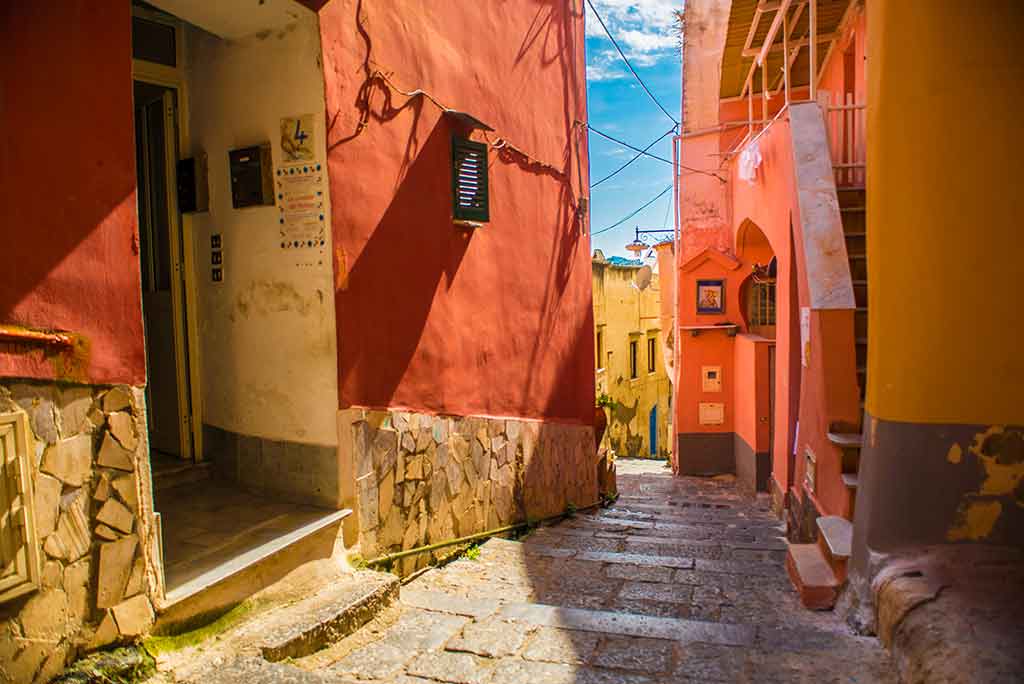
Porto Corricella in Procida
Among the islands that overlook the Gulf of Naples, Procida is the smallest, but no less precious for this reason. Its very name describes the morphology of the territory: from the Greek prochetai, which means' lying ', Procida seems in fact a body lying on the sea. The volcanic origin of the island is still recognizable in the craters of ancient times that are found in its gulfs that stretch in the form of a crescent. A land repeatedly remembered by works of literature and art, although small compared to Ischia and Capri, it remains the ideal tourist destination for those want to find, in a harsh and suggestive territory, the typical culture of a territory linked to the sea among lively colorful buildings.
Beaches The
island of Procida has a variety of beaches with unparalleled charm. The territory has five different beaches of very fine beach, on which a clear and mottled sea of blue opens. In front of Ischia is the beach of Chiaiolella, the longest beach in Procida, well equipped in the various bathing establishments and at sunset suggestive place from which admire the sun goes down. Also known in the local dialect Spiaggiolella, it houses numerous small clubs on the seafront and has become a real meeting place for families of bathers. In the name of tranquility you can spend time in what is called the “postman's beach”, the beach of Pozzo Old man, called with the curious nickname because it was precisely in this small space that numerous scenes from the movie “The Postman” were shot. Reachable by descending from the Cottimo it is in some areas equipped with bathing establishments that offer full services, but also has many free spaces. On this small beach, the little ones can take advantage of swimming courses or workshops of various kinds, while the older ones can enjoy a moment of relaxation and dedicate themselves to sports or to the small events that dot the summer period.
The beach of Chiaia, which can be reached from Piazza Olmo after a descent of about two hundred steps, is ideal for families with children because the water is shallow and the beach is in a position that protects it from the wind as from the waves. Behind it is overlooking the sea Marina Corricella, a characteristic landscape composed of overlapping colored houses, image delivered in numerous postcards and paintings from different eras. Beyond the beaches, the sea is also accessed through some cliffs of Procida. Not very well known compared to the most popular beaches, they allow you to bathe in unspoilt and very quiet areas; they are normally accessed by descents that give them their name: the descent Fiumicello (at the end of Via Schiano) and that of the hill of Santa Margherita Vecchia, which offers an admirable view of Vivara, a basin in the form of a crescent invaded by the waters, in fact the most small of the Neapolitan islands.
A weave of culture, art and nature
The Procidano tourist itinerary can only begin with the marinas. Since the ferry landing appears the Marina Grande, a commercial port framed by the houses in pastel color that are precisely the characteristic figure of the island. An ideal place for the purchase of souvenirs but above all local crafts, this stretch of the island keeps intact in its corners the importance of the sea in culture traditional, with its people of fishermen who have always fascinated artists and writers.
Marina Corricella, with its village, testify in the name the passage of the Greeks: in the innermost area of Corricella this area is called in fact” ; Callìa”, and “Coros Callos” in Greek means in fact beautiful district. An ancient place where there were the fishermen's homes, as in the different marinas, even here the houses follow one another, drawing a colorful landscape, and helping to remember the original usefulness of this characteristic: in fact, it is said that the many different colors used fishermen to recognize, from the sea, their home. Finally, from the comfortable beach of Chiaiolella lies the homonymous marina, with the typical boats called gozzi that tourists themselves can use.
The old town is located at the highest point of the island, 90 meters above sea level, and is called Terra Murata, recalling the name its old defensive function against invasions that during history and until the seventeenth century concerned the island. The walls were built by the Avalos family in 1500, like the well-known palace of Avalos (also called Castle), which in the 19th century became a prison and now it can be ograve; observe only from the outside. Instead, available to tourists is the abbey of San Michele Arcangelo, whose origins date back to the eleventh century but whose architecture, following destruction and reconstructions, dates back to the 16th century, and inside which you can admire paintings, sculptures and precious altars, as well as the lower area that houses the Museum, the Ossuary and the library that guards ancient manuscripts.
The
architectural elements that characterize Procida are, in addition to pastel colors, the 'vefio', a small balcony topped by a large arched vault. Observable a little everywhere on the island, it is an architectural element particularly admired in the Casale Vascello, the most famous group of houses built according to style seventeenth-century building.
The Procidano landscape, made of beaches, nature and rugged spaces, resistant to time, has fascinated numerous artists who helped to increase the charm of the island: how recall 'The Isle of Arturo' by Elsa Morante and the unforgettable Massimo Troisi, who sees Procida does not forget his enchantment.
This guide has been translated automatically through a third party service. Visititaly offers these automatic translations to help site visitors, however the automatic translations may contain inaccuracies, errors or inaccuracies. You can contact us to report inaccuracies or errors and we will check the translation.